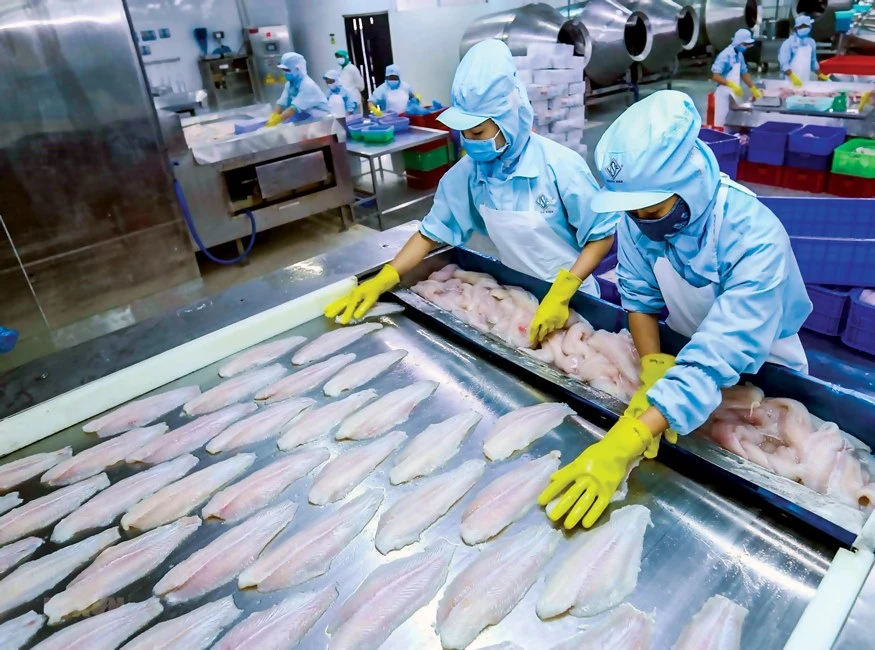
Material constraints
Frankly speaking, the drop in quality of breeding activities is the reason for the shortage of fries and fingerlings. Over the last few years, most fries and fingerlings are self-produced by farmers. Some farmers have applied tactics to push up production. This has been the main cause for the drop in quality of both fries and fingerlings. The death ratio has been increasing due to low quality of fingerlings which, in turn, caused higher costs of feed and medication.
The shortage of fingerlings had made the price go up significantly in 2017-2018. The excessive antibiotic residue is another risk which caused many shipments to be returned by importers. Furthermore, the low quality of fingerlings also caused low quality of finished pangasius products, such as not good color and low file ratio.
One more problem in the pangasius industry is the instability of material resources. When the export price increases, farmers expand their farming area immediately. They quickly transfer the agricultural fields to pangasius ponds or cages. These activities later create huge increase in supply and cause a drop in selling price of pangasius. Furthermore, most new farmers do not sign an agreement with processing companies to ensure the price and market for output.
Some loss carrying farmers stop farming in the next crop and cause shortage of pangasius material for file processing. If the export price increases again, this process of unsteady production will be repeated.
Lack of value-added pangasius products is another reason for export instability. 99% of pangasius exports are now raw processing products such as file or piece. The proportion of value added products like convenient foods or the products which are made from pangasius scrap like collagen, gelatin, surimi is very small given the limit in investment capital.
These products are favorites in some developed markets like US and Europe. Collagen or gelatin also have huge potential in the cosmetic industry.
Competition pressure
Most pangasius products are raw processing products, hence, pangasius companies have to face fierce competition in exports.
Furthermore, many companies have cheated their clients by using the glazing ratio which is known as ice-to-fish ratio. The higher ice glazing ratio, the lower ratio of file in 1 kg of finished product. According to international food standards (CODEX), the glazing ratio on frozen pangasius fillets for export should be 5%. However, several companies have ratio of 35-40%. As a result, the trust factor of international clients for Vietnam pangasius has dropped.
Some countries have sued Vietnam for dumping from their domestic market, which includes the USA who has already applied anti-dumping tax on pangasius products from Vietnam.
Since 2014, the government has been clearer on the strategy to develop this industry. Decree 36/2014/ND-CP and Decree 55/2017/ND-CP were issued to govern the activities of farming, processing and exporting of pangasius products. These two decrees also list the standards for measuring conditions in farming areas and quality of pangasius.
Many companies have invested heavily on creating a closed-loop supply chain, improving the quality of fingerlings, feed and materials, and targeting to stabilize the materials for processing of pangasius products.
In regards to fries and fingerlings, the national plan to ensure the supply of fingerlings has been implemented since 2018 with the joining of many scientists to create high quality fingerlings for the industry. The target of the plan is to meet 50% of the industry demand of fingerlings by 2020 and 70% by 2025.
According to pangasius processing companies, about 70% pangasius output of farmers has been assigned, via agreement with companies, at a price which earns farmers some profits and helps avoid price influence of traders and shortage of materials. The national standards for quality of pangasius was issued in 2017 to determine the glazing ratio and avoid unfair competition between companies. Several companies, which have capital and technology, have invested in research and development activities to create more value-added products.
For example, Vinh Hoan (VHC) has ready-to-eat and instant pangasius products. Collagen and gelatin products of the company are being well appreciated in Japan, US and European markets. Nam Viet (NVA) is running its final steps to launch surimi and collagen products and I.D.I (IDI) is studying to produce smoked pangasius, canned pangasius and pangasius sausages.
Decree 36/2014/ND-CP has created the foundation for the restructure of the pangasius industry in Vietnam. Although the solutions need time to adapt and change the industry completely, it shows the effort of the government to focus more on quality and sustainable growth.




















